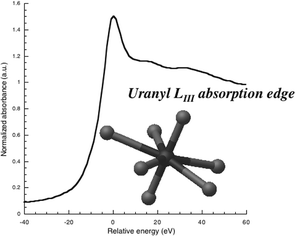Theoretical chemical contribution to the simulation of the LIII X-ray absorption edges of uranyl, neptunyl and osmyl hydrates and hydroxides
Abstract

* Corresponding authors
a DEN/DRCP/SCPS, CEA Marcoule, Bagnols sur Cèze cedex, France
b MST Division, Los Alamos National Laboratry, MS G755, PO Box 1663, Los Alamos, NM, USA
c Department of Physics, University of Washington, Seattle, WA, USA
d Institut de Physique Nucléaire d’Orsay, Bat 100, Orsay cedex, France

 Please wait while we load your content...
Something went wrong. Try again?
Please wait while we load your content...
Something went wrong. Try again?
C. Den Auwer, D. Guillaumont, P. Guilbaud, S. D. Conradson, J. J. Rehr, A. Ankudinov and E. Simoni, New J. Chem., 2004, 28, 929 DOI: 10.1039/B401607F
To request permission to reproduce material from this article, please go to the Copyright Clearance Center request page.
If you are an author contributing to an RSC publication, you do not need to request permission provided correct acknowledgement is given.
If you are the author of this article, you do not need to request permission to reproduce figures and diagrams provided correct acknowledgement is given. If you want to reproduce the whole article in a third-party publication (excluding your thesis/dissertation for which permission is not required) please go to the Copyright Clearance Center request page.
Read more about how to correctly acknowledge RSC content.
 Fetching data from CrossRef.
Fetching data from CrossRef.
This may take some time to load.
Loading related content
